September 1, 2009
Last weekend I took my annual pilgrimage to the summer home of the largest animal on the planet. Every summer, from June through November, hundreds of Blue Whales, which at up to 108 feet in length, are larger than any dinosaur that ever lived, spend their days foraging around the Farallon Islands. The Farallon Islands, 26 miles west of Ocean Beach, are within the boundaries of San Francisco, although only a minute percentage of San Francisco residents have ever traveled to the Islands.
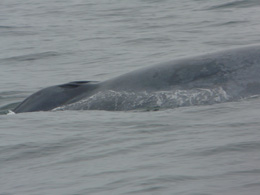 Each trip to the Farallons is amazingly different. While we only saw one possible Blue Whale (in the distance) on this trip, we were treated to spectacular views of 27 Humpback Whales, many of them performing acrobatics so close to the boat that you could hear their breathing.
Each trip to the Farallons is amazingly different. While we only saw one possible Blue Whale (in the distance) on this trip, we were treated to spectacular views of 27 Humpback Whales, many of them performing acrobatics so close to the boat that you could hear their breathing.
Humpbacks and Blues aren’t the only whales you can see at the Farallons. Gray Whales can be seen most of the year, mainly when they migrate past the islands from November through March on their annual journey between Alaska and Mexico. Five other species of whales (Sperm, Minke, Sei, Finn and Right Whales) have also been spotted near the Islands.
At least 23 species of marine mammals can be found here, which include many species of dolphins and porpoises, including Orcas (yes, Killer Whales are dolphins, not whales). Dolphins can often be seen in the hundreds, and they love to ride the bow of boats, which gives you close looks at these amazing animals. On one of my trip to the Islands nine years ago, a group of Pacific White Sided Dolphins rode the bow of the boat for half an hour. On the Islands themselves, you almost always see California Sea Lions, Stellar Sea Lions, Northern Elephant Seals, Harbor Seals and Northern Fur Seals. Starting each September, Great White Sharks show up to prey on the seals and sea lions for a couple of months.
The Islands got their name came from the 1603 diary of Father Antonio de la Ascencion, who described them as farallones (which means “rocky promontory rising from the ocean” in Spanish). These islands were the historical home of millions of marine mammals and sea birds. Many species were wiped out during the 18th, 19th and 20th century as successive forms of exploitation took aim at the wildlife on the island, from millions of seabird eggs for San Francisco’s Gold Rush to sea lion and fur seal fur for Russia.
Fortunately these islands are now a national sanctuary, and are the home of hundreds of thousands of birds and mammals once again. The islands are host to the largest breeding colony of seabirds in the lower 48 states. 12 species of seabirds nest on the island. My favorite of these breeding birds is the Tufted Puffin, with its large triangular orange beak. I’ve seen them on every trip to the Farallons (including four on this trip).
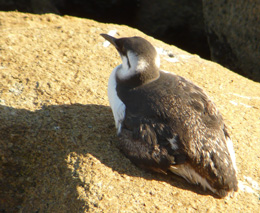
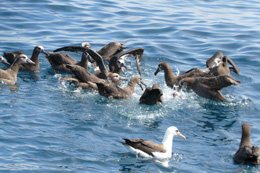 One of my other favorites is the Common Murre, a black and white bird that looks like (but isn’t related to) a penguin. At this time of year, you are most likely to see them on the ocean’s surface in father-child pairs (the father teaches the chick how to fish).
One of my other favorites is the Common Murre, a black and white bird that looks like (but isn’t related to) a penguin. At this time of year, you are most likely to see them on the ocean’s surface in father-child pairs (the father teaches the chick how to fish).
But the avian highlight of this trip was the Albatross. We saw more than 60 Black Footed Albatross, an endangered species that nests on the Hawaiian Islands and ranges across the north Pacific. In with the Black Footed Albatrosses was a Laysan Albatross, a much more common species, but one rarely seen near the Farallons since it is usually found much further out at sea.
Mammals and birds are not the only wildlife in the ocean. On the way back to the harbor, we passed through thousands of orange jellyfish, drifting just below and on the surface of the ocean.
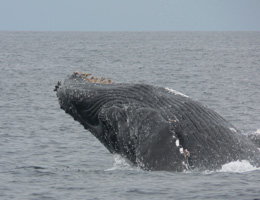
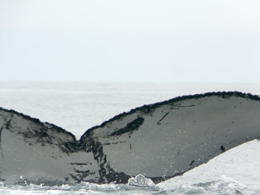 Whenever you take a trip to the Farallons (and the Oceanic Society runs weekend trips pretty much all year), you will see incredible wildlife. And each trip is different. On one trip, I was fortunate enough to see 21 Blues Whales, on another a Leatherback Turtle (weighing as much as a Volkswagen Beetle!) and on another hundreds of Northern Right Whale, Risso’s and Pacific White Sided Dolphins.
Whenever you take a trip to the Farallons (and the Oceanic Society runs weekend trips pretty much all year), you will see incredible wildlife. And each trip is different. On one trip, I was fortunate enough to see 21 Blues Whales, on another a Leatherback Turtle (weighing as much as a Volkswagen Beetle!) and on another hundreds of Northern Right Whale, Risso’s and Pacific White Sided Dolphins.
© Photos by David Assmann